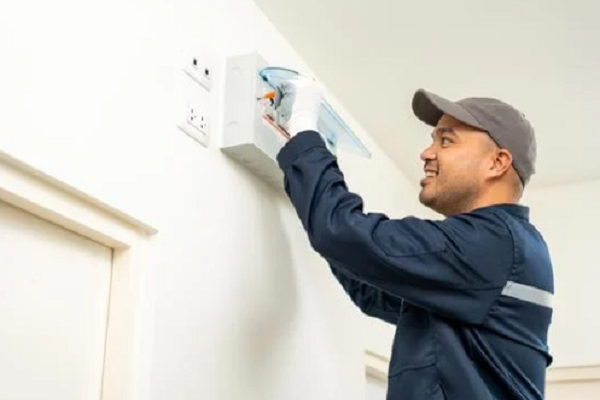Smart homes are becoming an integral part of modern living in Australia, offering convenience, efficiency, and advanced automation. However, integrating cutting-edge technology with electrical systems requires careful attention to safety. Ensuring your smart home operates smoothly without compromising safety is crucial, particularly as we embrace new advancements in 2025.
This guide highlights essential electrical safety tips for Australian smart homes, providing actionable advice to protect your family, devices, and home.
1. Invest in Surge Protection
As smart homes rely on a network of sensitive devices and appliances, protecting them from electrical surges is critical. Power surges, often caused by storms or grid fluctuations, can damage or destroy smart devices.
How to Safeguard Against Surges:
- Install a whole-home surge protector: This provides a first line of defense at your main electrical panel.
- Use individual surge protectors: Plug your most valuable smart devices into surge-protecting power boards.
- Check for lightning protection: If you live in areas prone to storms, ensure your surge protection includes lightning-resistant components.
2. Ensure Proper Grounding
A properly grounded electrical system prevents shocks and protects your devices. Grounding is especially important for homes equipped with smart systems that require consistent, stable power.
Steps to Verify Grounding:
- Hire a licensed electrician: Conduct an inspection to confirm your home’s grounding meets Australian safety standards.
- Upgrade old systems: If your smart home is in a renovated property, grounding may need updating.
- Add extra grounding for critical devices: Ensure components like smart hubs, thermostats, and home assistants are connected to grounded circuits.
3. Install Dedicated Circuits for High-Demand Devices
Smart homes often include high-power devices like EV chargers, HVAC systems, and advanced entertainment setups. Overloading circuits can lead to tripped breakers or fires.
Tips for Circuit Safety:
- Use dedicated circuits: Assign separate circuits to high-demand appliances.
- Upgrade your panel if needed: Consider upgrading to a higher-capacity electrical panel to handle increased loads.
- Consult an electrician: A professional can evaluate your home’s capacity and recommend circuit adjustments.
4. Regularly Inspect and Maintain Wiring
The increased load from smart home devices can put strain on your home’s electrical wiring. Faulty or outdated wiring poses a significant safety risk.
Wiring Maintenance Tips:
- Conduct routine inspections: Look for signs of wear, such as frayed wires or discoloration around outlets.
- Replace old wiring: If your home is more than 20 years old, consider upgrading the wiring to handle modern demands.
- Monitor for overheating: Warm outlets or frequent breaker trips may indicate wiring issues.
5. Optimize Wi-Fi and Smart Device Placement
Smart homes rely heavily on Wi-Fi connectivity. Poor device placement can lead to signal interference, overheating, and inefficient power usage.
Placement Tips:
- Avoid clustering devices: Spread devices evenly across your home to prevent power and Wi-Fi overload in one area.
- Keep devices ventilated: Ensure adequate airflow around devices like smart hubs and routers.
- Use smart plugs: These can help manage power usage and prevent overheating.
6. Choose Quality Components and Certified Installers
When expanding your smart home system, always prioritize quality components and professional installations. Substandard equipment can lead to safety hazards and frequent malfunctions.
What to Look For:
- Australian-certified products: Ensure all components meet national safety standards.
- Work with licensed professionals: Always hire certified electricians and technicians for installations.
- Avoid DIY for complex setups: Leave tasks like wiring and panel upgrades to experts.
7. Protect Outdoor Smart Devices
Outdoor smart devices, such as security cameras, motion sensors, and automated lighting, are exposed to weather conditions and require additional protection.
Outdoor Device Tips:
- Weatherproof installations: Use weather-resistant covers and sealants to protect wiring and outlets.
- Check for IP ratings: Ensure outdoor devices are rated for water and dust resistance (IP65 or higher is recommended).
- Regularly clean devices: Remove debris and dirt to maintain functionality and prevent overheating.
8. Secure Your Smart Home Network
While electrical safety is critical, the security of your smart home’s network is equally important. Cybersecurity breaches can compromise connected devices and lead to operational issues.
Network Security Best Practices:
- Use a strong password: Update your Wi-Fi password regularly and avoid using default credentials.
- Enable two-factor authentication: Secure your smart home hub with two-factor authentication for added protection.
- Install firmware updates: Keep your devices up-to-date to fix vulnerabilities and improve performance.
9. Plan for Power Outages
Smart homes require reliable power to function effectively. Power outages can disrupt systems, leaving you without essential services.
Power Backup Solutions:
- Invest in a UPS (Uninterruptible Power Supply): Use a UPS to keep critical devices like routers and smart hubs operational during outages.
- Consider solar power: Backup solar systems with batteries can provide additional reliability.
- Create manual overrides: Ensure critical functions, like locks and lighting, have manual alternatives in case of power loss.
10. Schedule Annual Electrical Inspections
With the complexity of smart home systems, regular professional inspections are crucial to identify potential hazards and maintain safety.
Benefits of Annual Inspections:
- Early problem detection: Catch minor issues before they escalate.
- Ensure compliance: Keep your home aligned with Australian standards.
- Optimize efficiency: An inspection can help improve energy efficiency and system performance.
👉 Contact our licensed electricians to schedule your annual smart home inspection and ensure your home remains safe and efficient.
Keep Your Smart Home Safe in 2025
Smart homes represent the future of living, but safety must always be a priority. By following these tips, you can ensure your smart home in Australia is protected against electrical risks, operates efficiently, and supports your modern lifestyle.
Don’t leave safety to chance. Whether you need help with installations, inspections, or upgrades, our team is here to assist. Get in touch today to ensure your smart home is safe, reliable, and ready for 2025.


 Your Local Reliable Electrician That You Can Trust
Your Local Reliable Electrician That You Can Trust 